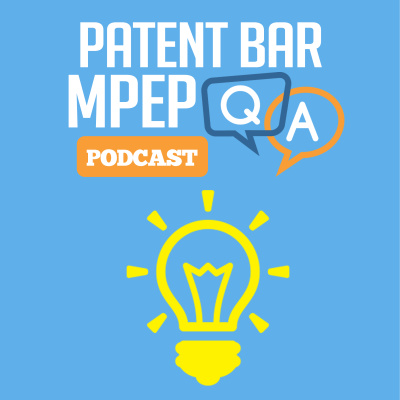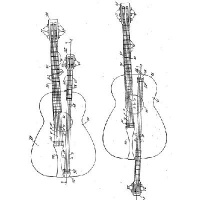Synopsis
Patent Bar Review
Episodes
-
MPEP Q & A 280: When does the revocation of a filing receipt license become effective?
18/07/2023 Duration: 02minQuestion: When does the revocation of a filing receipt license become effective? Answer: The revocation becomes effective on the date on which the notice is mailed. Chapter Details: The answer to this question can be found in chapter 100 of the MPEP. This chapter covers Secrecy, Access, National Security, and Foreign Filing. The answer is from the 9th Edition, Revision 10.2019. Depending on future changes to the MPEP, the question and answer may or may not be applicable in later Editions or revisions. Section Summary: This question and answer comes from section 140 of the MPEP. The following is a… The post MPEP Q & A 280: When does the revocation of a filing receipt license become effective? appeared first on Patent Education Series.
-
MPEP Q & A 279: Methods of paying a maintenance fee and necessary surcharges
04/07/2023 Duration: 03minQuestion: How can a maintenance fee and any necessary surcharge be made? Answer: The method of payment for the maintenance fee and any necessary surcharge shall be made in U.S. dollars and in the form of a cashier’s or certified check, Treasury note, national bank notes, or United States Postal Service money order as provided in 37 CFR 1.23(a). If the maintenance fee and any necessary surcharge is sent in any other form, the Office may delay or cancel the credit until collection is made. For example, a personal or other uncertified check drawn on a U.S. bank that is… The post MPEP Q & A 279: Methods of paying a maintenance fee and necessary surcharges appeared first on Patent Education Series.
-
MPEP Q & A 278: Claiming the benefit of a provisional application
20/06/2023 Duration: 03minQuestion: What does a petition under 37 CFR 1.78(b) require? Answer: A petition under 37 CFR 1.78(b) requires: (A) the reference required by 35 U.S.C. 119(e)and 37 CFR 1.78 to the prior-filed provisional application, which must be included in application data sheet (unless previously submitted in an application data sheet); (B) the petition fee as set forth in 37 CFR1.17(m); and (C) a statement that the delay in filing the nonprovisional application or international application designating the United States within the twelve-month period set forth in 37 CFR1.78(a)(1)(i) was unintentional. The Director may require additional information where there is a… The post MPEP Q & A 278: Claiming the benefit of a provisional application appeared first on Patent Education Series.
-
MPEP Q & A 277: Exceptions to extensions of time
06/06/2023 Duration: 03minQuestion: 37 CFR 1.136(a) permits an applicant to file a petition for extension of time and a fee up to 5 months after the end of the time period set to take action except during which circumstances? Answer: 37 CFR 1.136(a) permits an applicant to file a petition for extension of time and a fee asset forth in 37 CFR 1.17(a) up to 5 months after the end of the time period set to take action except: (A) where prohibited by statute, (B) where prohibited by one of the items listed in the rule, or (C) where applicant has been… The post MPEP Q & A 277: Exceptions to extensions of time appeared first on Patent Education Series.
-
MPEP Q & A 276: Examples of exemplary rationales of a prima facie case of obviousness
23/05/2023 Duration: 03minQuestion: What are some examples of rationales that may support a conclusion of obviousness? Answer: Examples of rationales that may support a conclusion of obviousness include: (A) Combining prior art elements according to known methods to yield predictable results; (B) Simple substitution of one known element for another to obtain predictable results; (C) Use of known technique to improve similar devices (methods, or products) in the same way; (D) Applying a known technique to a known device (method, or product) ready for improvement to yield predictable results; (E) “Obvious to try” – choosing from a finite number of identified, predictable… The post MPEP Q & A 276: Examples of exemplary rationales of a prima facie case of obviousness appeared first on Patent Education Series.
-
MPEP Q & A 275: Receipt of drawing after the filing date
09/05/2023 Duration: 03minQuestion: What actions should happen if an examiner discovers new matter in a substitute or additional drawing? Answer: If the examiner discovers new matter in a substitute or additional drawing, the drawing should not be entered and the examiner should describe the new matter that resulted in non-entry in the next Office action. A new drawing without such new matter maybe required if the examiner determines that a drawing is needed under 37 CFR 1.81 or 37 CFR 1.83. The examiner’s decision would be reviewable by filing a petition under 37 CFR 1.181.The Technology Center (TC) Director would decide such… The post MPEP Q & A 275: Receipt of drawing after the filing date appeared first on Patent Education Series.
-
MPEP Q & A 274: Inspection of patent files by the public
25/04/2023 Duration: 03minQuestion: During what conditions would the complete file wrapper and contents of a patent application published in redacted form not be available? Answer: If an application was published in redacted form, the complete file wrapper and contents of the patent application will not be available if: The requirements of paragraphs (d)(1), (d)(2), and (d)(3) of § 1.217 have been met in the application; and the application is still pending. Chapter Details: The answer to this question can be found in chapter 100 of the MPEP. This chapter covers Secrecy, Access, National Security, and Foreign Filing. The answer is from the… The post MPEP Q & A 274: Inspection of patent files by the public appeared first on Patent Education Series.
-
MPEP Q & A 273: Can a request for ex parte reexamination filed on or after January 16, 2018 be filed with a reduced filing fee?
11/04/2023 Duration: 02minQuestion: Can a request for ex parte reexamination filed on or after January 16, 2018 be filed with a reduced filing fee? Answer: Yes, requests for ex parte reexamination filed on or after January 16, 2018 may be filed with a reduced filing fee. This reexamination filing option was created to make it financially less burdensome for requesters with limited resources. Chapter Details: The answer to this question can be found in chapter 2200 of the MPEP. This chapter covers Citation of Prior Art and Ex Parte Reexamination of Patents. The answer is from the 9th Edition, Revision 10.2019. Depending on future changes… The post MPEP Q & A 273: Can a request for ex parte reexamination filed on or after January 16, 2018 be filed with a reduced filing fee? appeared first on Patent Education Series.
-
MPEP Q & A 272: Limitation that the courts have found not to be enough to qualify as “significantly more” when recited in a claim with a judicial exception.
28/03/2023 Duration: 04minQuestion: Name a limitation that the courts have found not to be enough to qualify as “significantly more” when recited in a claim with a judicial exception. Answer: Limitations that the courts have found not to be enough to qualify as “significantly more” when recited in a claim with a judicial exception include: Adding the words “apply it” (or an equivalent) with the judicial exception, or mere instructions to implement an abstract idea on a computer, e.g.,a limitation indicating that a particular function such as creating and maintaining electronic records is performed by a computer; Simply appending well-understood, routine, conventional activities… The post MPEP Q & A 272: Limitation that the courts have found not to be enough to qualify as “significantly more” when recited in a claim with a judicial exception. appeared first on Patent Education Series.
-
MPEP Q & A 271: What are three pieces of information each patent listed in the Official Gazette may give?
14/03/2023 Duration: 03minQuestion: What are three pieces of information each patent listed in the Official Gazette may give? Answer: As to each patent listed in the Official Gazette, the following information may be given: (A) Patent number; (B) Title of the invention; (C) Name of inventor(s), city, and state or country of residence; (D) Assignee’s name, city, and state or country of residence, if assigned; (E) Applicant’s name, city, and state or country of residence; (F) Filing date and application number; (G) For reissue patents, the original patent number and issue date, and the original application number and filing date; (H) U.S.… The post MPEP Q & A 271: What are three pieces of information each patent listed in the Official Gazette may give? appeared first on Patent Education Series.
-
MPEP Q & A 270: Once an appellant has filed a notice of appeal, what situations may that appellant request that prosecution be reopened for?
28/02/2023 Duration: 03minQuestion: Once an appellant has filed a notice of appeal, what situations may that appellant request that prosecution be reopened for? Answer: Once appellant has filed a notice of appeal, appellant also may request that prosecution be reopened for the following situations: In response to a new ground of rejection made in an examiner’s answer, appellant may file a reply in compliance with 37 CFR 1.111 that addresses the new ground of rejection within two months from the mailing of the examiner’s answer In response to a substitute examiner’s answer that is written in response to a remand by the… The post MPEP Q & A 270: Once an appellant has filed a notice of appeal, what situations may that appellant request that prosecution be reopened for? appeared first on Patent Education Series.
-
MPEP Q & A 269: Two laboratory techniques the courts have recognized as well-understood, routine, conventional activities in the life science arts
14/02/2023 Duration: 03minQuestion: List two laboratory techniques the courts have recognized as well-understood, routine, conventional activities in the life science arts when they are claimed in a merely generic manner (e.g., at a high level of generality) or as insignificant extra-solution activity. Answer: The courts have recognized the following laboratory techniques as well-understood, routine, conventional activity in the life science arts when they are claimed in a merely generic manner (e.g., at a high level of generality) or as insignificant extra-solution activity: Determining the level of a biomarker in blood by any means; Using polymerase chain reaction to amplify and detect DNA; Detecting DNA… The post MPEP Q & A 269: Two laboratory techniques the courts have recognized as well-understood, routine, conventional activities in the life science arts appeared first on Patent Education Series.
-
MPEP Q & A 268: What should the examiner do?
31/01/2023 Duration: 03minQuestion: If the Board affirms a rejection against independent claim 1, reverses all rejections against dependent claim 2 and claim 3 is allowed, after expiration of the period for further appeal, what should the examiner do? Answer: If the Board affirms a rejection against independent claim 1, reverses all rejections against dependent claim 2 and claim 3 is allowed, after expiration of the period for further appeal, the examiner should either: Convert dependent claim 2 into independent form by examiner’s amendment, cancel claim 1 in which the rejection was affirmed, and issue the application or ex parte reexamination certificate with claims 2… The post MPEP Q & A 268: What should the examiner do? appeared first on Patent Education Series.
-
MPEP Q & A 267: What are the four purposes 35 U.S.C. 101 has been interpreted as imposing?
17/01/2023 Duration: 04minQuestion: What are the four purposes 35 U.S.C. 101 has been interpreted as imposing? Answer: 35 U.S.C. 101 has been interpreted as imposing four purposes. First, 35 U.S.C. 101 limits an inventor to ONE patent for a claimed invention. If more than one patent is sought, a patent applicant will receive a statutory double patenting rejection for claims included in more than one application that are directed to the same invention. Second, the inventor(s) must be the applicant in an application filed before September 16, 2012, (except as otherwise provided in pre-AIA 37 CFR 1.41(b)) and the inventor or each… The post MPEP Q & A 267: What are the four purposes 35 U.S.C. 101 has been interpreted as imposing? appeared first on Patent Education Series.
-
MPEP Q & A 266: Name one advantage a CPA has compared to a continuation or divisional application
03/01/2023 Duration: 03minQuestion: Name one advantage a CPA has compared to a continuation or divisional application filed under 37 CFR 1.53(b). Answer: A CPA has a number of advantages compared to a continuation or divisional application filed under 37 CFR 1.53(b). For example, the papers required to be filed in the U.S. Patent and Trademark Office in order to secure a filing date under 37 CFR 1.53(d) are minimal compared to 37 CFR 1.53(b). In addition, the Office will not normally issue a new filing receipt for a CPA. See 37 CFR 1.54(b). The time delay between the filing date and the… The post MPEP Q & A 266: Name one advantage a CPA has compared to a continuation or divisional application appeared first on Patent Education Series.
-
MPEP Q & A 265: What is the second part of the Alice/Mayo test often referred to as?
20/12/2022 Duration: 03minQuestion: What is the second part of the Alice/Mayo test often referred to as? Answer: The second part of the Alice/Mayo test is often referred to as a search for an inventive concept. An inventive concept “cannot be furnished by the unpatentable law of nature (or natural phenomenon or abstract idea) itself.” Genetic Techs. v. Merial LLC. Instead, an “inventive concept” is furnished by an element or combination of elements that is recited in the claim in addition to (beyond) the judicial exception, and is sufficient to ensure that the claim as a whole amounts to significantly more than the judicial exception itself. Alice Corp.… The post MPEP Q & A 265: What is the second part of the Alice/Mayo test often referred to as? appeared first on Patent Education Series.
-
MPEP Q & A 264: How do examiners evaluate integration into a practical application?
06/12/2022 Duration: 03minQuestion: How do examiners evaluate integration into a practical application? Answer: Examiners evaluate integration into a practical application by: (1) identifying whether there are any additional elements recited in the claim beyond the judicial exception(s); and (2) evaluating those additional elements individually and in combination to determine whether they integrate the exception into a practical application. Many of these considerations overlap, and often more than one consideration is relevant to analysis of an additional element. Chapter Details: The answer to this question can be found in chapter 2100 of the MPEP. This chapter covers Patentability. The answer is from the… The post MPEP Q & A 264: How do examiners evaluate integration into a practical application? appeared first on Patent Education Series.
-
MPEP Q & A 263: How is the markedly different characteristics analysis performed?
22/11/2022 Duration: 03minQuestion: How is the markedly different characteristics analysis performed? Answer: The markedly different characteristics analysis compares the nature-based product limitation to its naturally occurring counterpart in its natural state. Markedly different characteristics can be expressed as the product’s structure, function, and/or other properties, and are evaluated based on what is recited in the claim on a case-by-case basis. If the analysis indicates that a nature-based product limitation does not exhibit markedly different characteristics, then that limitation is a product of nature exception. If the analysis indicates that a nature-based product limitation does have markedly different characteristics, then that limitation is… The post MPEP Q & A 263: How is the markedly different characteristics analysis performed? appeared first on Patent Education Series.
-
MPEP Q & A 262: Give an example of a claim that does not recite mental processes because it cannot be practically performed in the human mind.
08/11/2022 Duration: 03minQuestion: Give an example of a claim that does not recite mental processes because it cannot be practically performed in the human mind. Answer: Examples of claims that do not recite mental processes because they cannot be practically performed in the human mind include: a claim to a method for calculating an absolute position of a GPS receiver and an absolute time of reception of satellite signals, where the claimed GPS receiver calculated pseudoranges that estimated the distance from the GPS receiver to a plurality of satellites, SiRF Tech; a claim to detecting suspicious activity by using network monitors and analyzing… The post MPEP Q & A 262: Give an example of a claim that does not recite mental processes because it cannot be practically performed in the human mind. appeared first on Patent Education Series.
-
MPEP Q & A 261: What is meant by a fundamental economic practice or principle?
25/10/2022 Duration: 02minQuestion: What is meant by a fundamental economic practice or principle? Answer: The courts have used the phrases “fundamental economic practices” or “fundamental economic principles” to describe concepts relating to the economy and commerce. Fundamental economic principles or practices include hedging, insurance, and mitigating risks. The term “fundamental” is not used in the sense of necessarily being “old” or “well-known.” However, being old or well-known may indicate that the practice is fundamental. Chapter Details: The answer to this question can be found in chapter 2100 of the MPEP. This chapter covers Patentability. The answer is from the 9th Edition, Revision… The post MPEP Q & A 261: What is meant by a fundamental economic practice or principle? appeared first on Patent Education Series.






